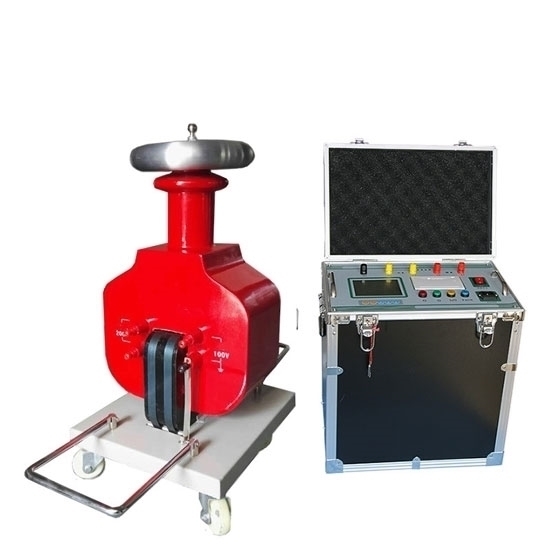Hipot tester is one of the main methods to test the ability of electrical appliances, electrical equipment, electrical installations, electrical lines and electrical safety appliances to withstand overvoltage. There are two types of power frequency withstand voltage test and DC withstand voltage test. The test voltage of the power frequency withstand voltage test is more than one to several times the rated voltage of the equipment under test, not less than 1000V.
The pressurization time: 1 minute for equipment with porcelain and liquid as the main insulation, 5 minutes for equipment with organic solids as the main insulation, 3 minutes for voltage transformers, and 10 minutes for oil-immersed power cables. Electrical equipment can find local defects, moisture and aging of insulation through withstand voltage test. AC withstand voltage test: conducted at 2.5 times or above the voltage of the device under test, from the point of view of thermal breakdown of dielectric loss, it can effectively find local free defects and weak points of insulation aging. Since the voltage is mainly divided by the capacitor under the alternating voltage, the insulation defects of the equipment can be effectively exposed.
Generally, when choosing a hipot tester, there may be errors in understanding and understanding safety standards. The general safety standards require that the tripping current is 100mA, and the short-circuit current needs to reach 200mA. If it is directly interpreted as the so-called 200mA of the Hipot Tester, that’s a serious mistake.
We know that when the output withstand voltage is 5KV; if the output current is 100mA, the withstand voltage tester has an output capacity of 500VA (5KV X 100mA), and when the current output is 200mA, it needs to double the output capacity to 1000VA , such a misinterpretation will cause the burden of the cost of additional equipment, if the budget is limited; originally two instruments could be purchased, because of the misinterpretation, only one can be purchased. Therefore, from the above description, it can be found that in fact, the manufacturer chooses a withstand voltage tester, and whether to choose a large-capacity and wide-range instrument depends entirely on the characteristics of its products and the requirements of the standard. If you choose a wide-range instrument and equipment , it will be a very big waste, the basic principle is that if enough is enough, it is in line with economic benefits.

The professional hipot tester uses the transformer method to measure the voltage, and its comprehensive error consists of two parts: the error of the transformer and the error of the secondary side indicator (voltmeter). Under normal circumstances, Dingsheng power standard transformers (standard voltage transformers, standard current transformers) for measurement have high accuracy, usually above 0.5. If the accuracy of the transformer is more than two levels higher than that of the indicator, its error can be ignored. In addition to considering its error factors, the voltmeter matched with the transformer should also meet the following two conditions:
The range of the voltmeter should be as consistent as possible with the rated secondary voltage of the transformer;
The total impedance of the voltmeter should be within the rated allowable range of the transformer.
Reminder: The voltage transformer method is only suitable for measuring the AC voltage value.
Normally, the voltage waveform in a power system is a sine wave. During the operation of the power system, due to lightning strikes, operation, faults or improper parameter matching of electrical equipment, the voltage of some parts of the system suddenly rises and greatly exceeds its rated voltage, which is overvoltage. Overvoltage can be divided into two categories according to its causes. One is the overvoltage caused by direct lightning strike or lightning induction, which is called external overvoltage. The magnitude of lightning impulse current and impulse voltage are large, and the duration is very short, which is extremely destructive. However, because the overhead lines of 3-10kV and below in towns and general industrial enterprises are shielded by workshops or tall buildings, the probability of being directly struck by lightning is very small, which is relatively safe.
Moreover, what is discussed here is household electrical appliances, which is not within the above-mentioned scope, and will not be discussed further. The other type is caused by energy conversion or parameter changes inside the power system, such as fitting the no-load line, cutting off the no-load transformer, and single-phase arc grounding in the system, which is called internal overvoltage. Internal overvoltage is the main basis for determining the normal insulation level of various electrical equipment in the power system. That is to say, the design of the insulation structure of the product should not only consider the rated voltage but also consider the internal overvoltage of the environment where the product is used. The withstand voltage test is to detect whether the insulation structure of the product can withstand the internal overvoltage of the power system.
The Hipot tester is mainly used to test the withstand voltage capability of various electrical devices, insulating materials and insulating structures. The withstand voltage tester can adjust the test voltage and set the breakdown current. According to the technical requirements of the verification regulations, this paper recommends several detection methods of output voltage.
There are 4 detection methods for the output voltage of the hipot tester:
1. Electrostatic voltmeter method
2. Voltage transformer method
3. Voltage divider with voltmeter method
4. High resistance box with milliamp meter method
The hipot tester is mainly used to test the withstand voltage capability of various electrical devices, insulating materials and insulating structures. The hipot tester can adjust the size of the test voltage and set the breakdown current.
